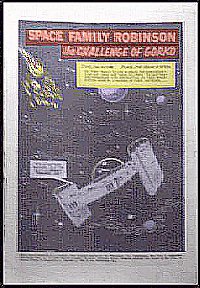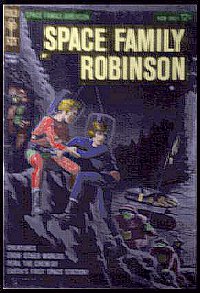

SFR was the joint creation of editor and writer Del Connell and artist Dan Spiegle.
Connell was the artistic director of Dell and Gold Key, a job he held since the early 1950s after a stint in the art department at Disney. Spiegle is a versatile
California-based illustrator who ably turned out an astonishing variety of
assignments for Gold Key throughout the '60s, from fanciful fare like
their original movie adaptation of Disney's Mary Poppins, to
straight adventure like Jonny Quest, to superheroics like
Space Ghost and The Green Hornet.
Spiegle obviously enjoyed creating the unique look of Space Family
Robinson. He displayed a distinctive style for rendering futuristic
settings which, in the '60s set him apart from most of his East Coast
peers in the industry. Despite the typical "comic book" scientific
inaccuracies and gosh-wow "Buck Rogers-isms" that often crept in
to mar SFR scripts, Spiegle's space hardware and alien
architecture showed the overall influence that shaped the work of West
Coast artists like world-class illustrator and futurist designer Syd
Mead.
They were quite novel and convincing when compared with the dated
designs of most of the other established comic artists of the time: here
were alien cities that looked alien, instead of those interminable
Flash Gordonesque depictions of alien worlds as something like a
outlandish hybrid of all the World's Fairs held between the turn of the
century and 1940. And while the Robinsons' own technology was
quite streamlined and almost advanced enough to blend in with the
hardware of many of the alien races they encountered, Spiegle didn't
shrink from the challenge of differentiating the alien guest stars'
buildings and vehicles by clever design. Even if it was simply by either
creating something looking just a bit more exotic, or by going to the
other extreme and using something even more plain. As our selection of
SFR pictures here on our pages show, Spiegle's 1960s designs, while
dated in some ways, are still worthy of study after four decades.
An interesting sample of Dan Spiegle's work from the SFR era is now available online. In the late 60s, Mattel Inc. introduced Major Matt Mason, a posable astronaut action figure that served as a boys' counterpart to Barbie. Like Barbie, the major and his crew came with a large array of vehicles and accessories. For some reason, Western didn't get the license for publishing Major Matt Mason comics through Gold Key. DC Comics was approached to create one, but the project failed. Meanwhile, Western had secured the rights for Major Matt Mason coloring and activity books to be published through its Whitman Publishing division. The coloring book was co-illustrated by Dan, and a complete set of scans from its pages can be downloaded for viewing at The Space Station, Keith Mayer's Major Matt Mason HQ site.
Spiegle was an excellent illustrator, always good at consistently following the specified design scheme of licensees, even at the expense of displaying his creativity. Fortunately, the coloring book's scant storyline required Dan to design many things beyond the scope of the Matt Mason toy line, and a lot of these items would have fit right into the pages of Space Family Robinson.

Dan Spiegle is still very active in comics illustration. One of his most notable recent projects was the taking on of the drawing chores for Tribune Syndicate's revival of Milt Caniff's classic newspaper comic strip Terry and the Pirates in 1998.
For an interesting look at what Dan Spiegle's drawing board has been turning out these days, there's a great deal of information and commentary about him at www.evanier.com, the Web site of Mark Evanier, veteran comics writer and one of Dan's former colleagues at Gold Key Comics.
There is a factoid about the origin of Space Family Robinson
that used to be mentioned in passing in the listing for SFR in
the annual Overstreet Comics Price Guide. It's said that Carl Barks, the
guiding writer/artist of Uncle Scrooge fame, whose work is best
known to '90s audiences as the basis for Disney's Duck Tales, may
have originated the premise. Since he had been working with Dell, and
undoubtedly had dealings with Gold Key after Uncle Scrooge and
Walt Disney's Comics and Stories became Gold Key titles, it's a
reasonable notion that a Barks version of the SFR premise may
have been floating around in office conversation for awhile.
In recent years, comics historians have also asserted that this only a rumor, perhaps based on the general stylistic resemblance between the flavor of Barks' occasional science fiction-flavored stories in Uncle Scrooge and Connell's writing in Space Family Robinson.
This was further confirmed in Ed Shifres' 1996 book, Lost in Space: the Untold Story, where the author reported Carl Barks' statements from a personal letter written in 1991.
Barks affirmed that the notion of a "Swiss Family Robinson in space" had crossed his mind, and he did indeed write a short memo suggesting such a comic series, circa 1960-61. This memo was, however, directed to a different editor, Chase Craig, who would shortly after create another Gold Key original, Magnus: Robot Fighter. Barks also affirmed that Del Connell was responsible for the creation of Space Family Robinson.
This page last modified June 30, 2008.